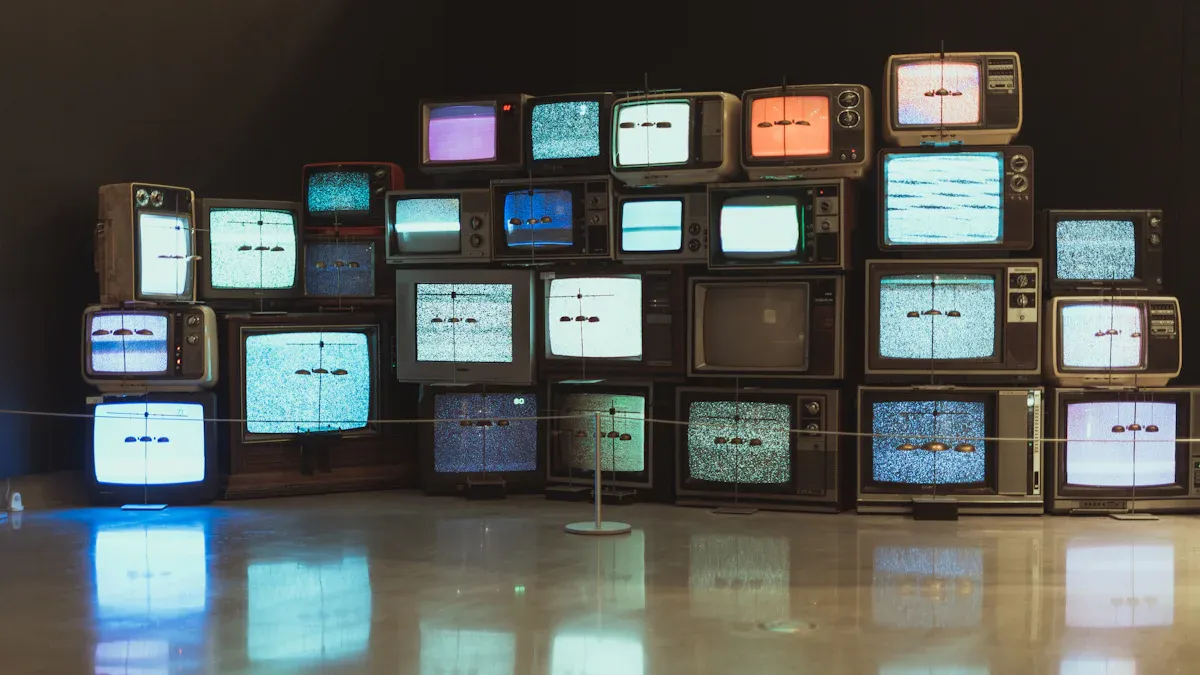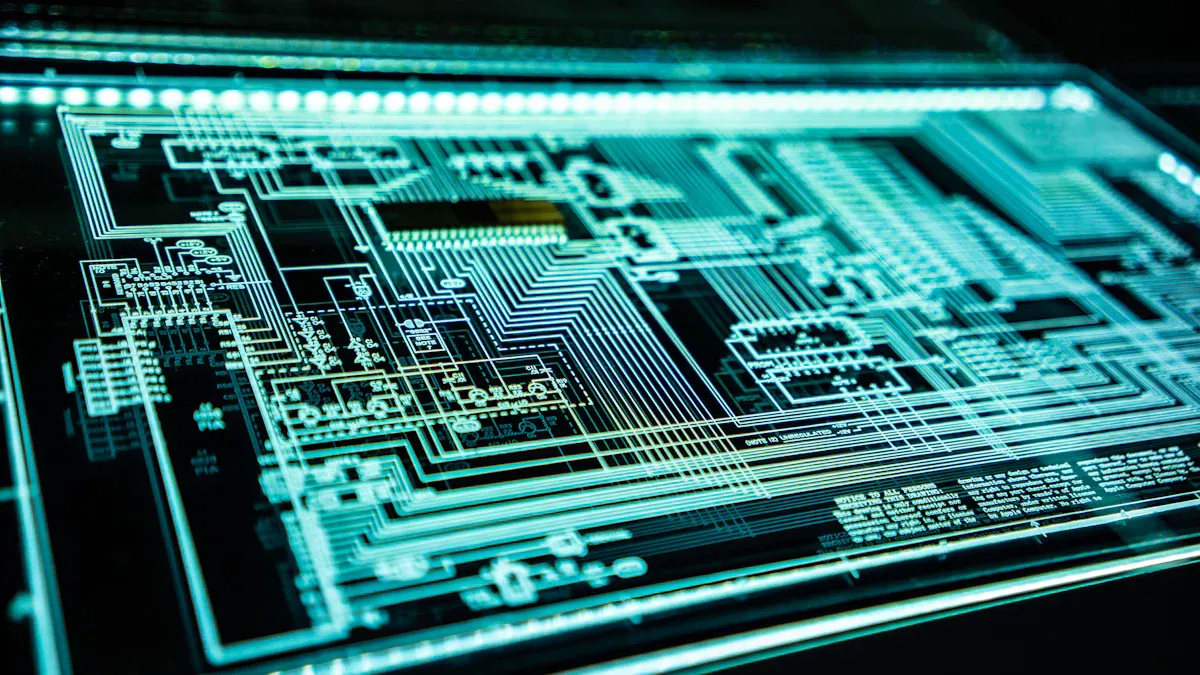QNED vs OLED Which TV Technology Stands Out in 2025

Choosing the best TV for your home in 2025 involves considering factors like brightness, picture quality, and price. QNED vs OLED TVs are popular options because they excel in these areas. High-end TVs now boast brightness levels exceeding thousands of nits, ensuring they look stunning even in well-lit rooms. Features such as full-array local dimming and 120Hz refresh rates enhance picture clarity and make viewing more thrilling. Gamers will appreciate TVs with input lag under 10ms, as they provide incredibly fast response times. To make an informed decision between QNED and OLED, it's essential to understand their differences to determine which one suits your needs best.
Key Takeaways
QNED TVs are very bright, great for sunny rooms. They use mini-LEDs and quantum dots to show bright colors.
OLED TVs have amazing picture quality with deep blacks and great contrast. They are perfect for people who love movies and games.
Think about your room's lighting when picking a TV. QNED works well in bright spaces, while OLED is better in dark rooms.
QNED TVs cost less and use less energy, so they are good for saving money.
OLED TVs can get burn-in, but QNED TVs do not. This makes QNED safer for watching different types of shows.
Understanding QNED and OLED Technologies

What Is QNED? Features and Benefits
QNED stands for Quantum Nano Emitting Diode. It’s a big step forward in TV tech. This type of TV mixes quantum dots with mini-LED backlights. The result is brighter screens and better colors. QNED TVs give viewers an amazing experience and are a strong choice in the market.
One great thing about QNED is its brightness. It’s brighter than regular LED TVs. This makes it perfect for watching during the day or in bright rooms. Quantum dots make colors pop, and mini-LEDs improve contrast by dimming specific areas.
QNED TVs also save energy. They use less power while still showing clear pictures. Many QNED TVs have features like 120Hz refresh rates. This makes them great for gaming and fast-moving shows.
What Is OLED? Features and Benefits
OLED means Organic Light Emitting Diode. It’s a game-changing TV technology. Unlike QNED, OLED pixels light up on their own. There’s no need for a backlight, so the screens are thinner and use less energy.
OLED TVs are famous for their deep blacks and amazing contrast. Each pixel can turn off completely, making dark scenes look super real. Movie lovers will love OLED for its theater-like quality.
Other perks of OLED include wide viewing angles and accurate colors. The picture looks great whether you sit in the middle or to the side. But OLEDs can wear out faster if they get too hot. For example, a 10°C rise in heat might shorten their life by 30% at high brightness levels.
If you want a 4K OLED TV, expect sharp and detailed images. They show HDR content beautifully, making everything look lifelike. Gamers also love OLED TVs because they respond quickly and have low input lag.
QNED vs OLED: Performance Comparison

Picture Quality: Color Accuracy and Contrast
Comparing QNED and OLED shows big differences in picture quality. QNED TVs use quantum dots to make colors bright and vivid. This makes them great for rooms with lots of light. OLED TVs, however, are better at showing accurate colors and deep contrast. Each OLED pixel lights up on its own, creating perfect blacks. This makes dark scenes look more realistic without any light spilling over.
Here’s a simple comparison:
TV Type | Contrast | ||
|---|---|---|---|
OLED | Excellent | Excellent | Perfect |
QNED | Bright & Vivid | Good | Not Perfect |
If you love movies and want the best picture, OLED is ideal. But QNED is a great choice for bright spaces with vibrant colors.
Brightness and HDR Performance
Brightness matters when choosing a TV for different lighting. QNED TVs are brighter than OLED, making them better for sunny rooms. OLED TVs, though, shine in darker spaces. Their infinite contrast and HDR abilities make details pop in dim settings.
Here’s a brightness comparison:
Measurement Type | SDR (nits) | HDR (nits) |
|---|---|---|
100-300 | Up to 10,000 |
QNED wins in brightness, but OLED gives a richer HDR experience. For watching 4K HDR movies, OLED is hard to beat.
Black Levels and Viewing Angles
Black levels and viewing angles affect how good a TV looks. OLED TVs create true blacks by turning off pixels completely. This gives amazing depth and contrast. QNED TVs still have some light bleed, which can make dark scenes look less clear.
Viewing angles are also better with OLED. The picture stays sharp even from the side. QNED TVs lose some brightness and color accuracy at wide angles. Here’s a quick comparison:
Feature | QNED | OLED |
|---|---|---|
Black Levels | Light bleed, no true blacks | True blacks with self-lit pixels |
Viewing Angles | Loses quality at wide angles | Stays clear from all angles |
For true blacks and great viewing angles, OLED is the winner. But QNED’s brightness makes it a strong pick for bright rooms.
Gaming Performance: Refresh Rates and Input Lag
Gaming on a TV needs quick response and smooth visuals. Both QNED and OLED TVs are great for gaming but differ in key features.
QNED TVs often have refresh rates of 120Hz or higher. This makes fast-moving games look smooth and reduces motion blur. Quantum dots and mini-LEDs make images sharp and colorful. Input lag is very low, usually under 10ms, for fast responses.
OLED TVs are known for their amazing picture quality in games. Each pixel lights up on its own, giving perfect contrast and deep blacks. They also support high refresh rates but stand out with super-fast response times. This removes motion blur and ghosting, helping in games needing quick reactions.
For gamers, the choice depends on what matters most. If you like bright screens and bold colors, QNED is a good pick. But if you want the best visuals and smooth motion, OLED is better. Your gaming style and room lighting will help you decide.
Pricing and Value for Money
Price is important when picking a TV. QNED TVs are usually cheaper than OLED ones. They are a good choice for buyers who want bright screens and great colors without spending too much. QNED TVs also save energy, lowering electricity bills over time.
OLED TVs cost more but offer top-notch picture quality. They show true blacks and amazing contrast, making them perfect for movies and gaming. However, their higher price might not fit everyone’s budget.
Think about your needs when deciding on price and value. If you want a budget-friendly TV with strong performance, go for QNED. If you’re ready to spend more for the best visuals, OLED is worth it.
BOE's Role in Advancing Display Technologies
BOE's Innovations in QNED Technology
BOE is leading the way in improving QNED TVs. They mix quantum dots with mini-LED backlights for better brightness and colors. This makes QNED TVs a strong choice in the market. BOE spends a lot on research to improve display technology. In 2022, they spent $1.8 billion on new ideas like QNED.
At the 2024 CES event, BOE showed off amazing products. One was a 110-inch 16K 3D screen that doesn’t need glasses. This showed how they add cool features to big screens. BOE also works on high-refresh-rate displays. They won a big science award in 2021 for their efforts. These successes prove BOE is shaping the future of QNED TVs.
BOE's Contributions to OLED Advancements
BOE has helped OLED TVs become even better. OLED TVs have pixels that light up on their own, giving great picture quality. BOE is one of the top companies filing patents for OLED tech. In 2021, they filed 1,980 patents, showing their focus on OLED.
At the 2024 CES, BOE introduced flexible OLED screens. These can bend and are useful for many things, not just TVs. They also showed clear OLED panels, which are see-through. BOE’s work makes OLED TVs better with deep blacks, bright colors, and wide viewing angles. Their ideas also help OLEDs work in other industries.
BOE’s work in QNED and OLED shows their dedication to new ideas. Whether you want QNED for brightness or OLED for amazing pictures, BOE ensures top-quality technology.
Use Cases: Choosing Between QNED and OLED
Best for Movie Lovers
If you love watching movies, OLED TVs are amazing. Their pixels light up on their own, creating perfect blacks and endless contrast. This makes dark scenes in movies look super real and detailed. OLED TVs also show colors exactly as they should be, just like the director wanted. You can sit anywhere in the room and still see a great picture. This makes OLED perfect for family movie nights.
QNED TVs, however, are very bright and colorful. They work well in rooms with lots of light, where other TVs might look dull. While QNED TVs are great, OLED is the best choice for movie fans who want a theater-like experience at home. When comparing the two, OLED wins with its better blacks and contrast.
Best for Gamers
Both QNED and OLED TVs are good for gaming, but they have different strengths. OLED TVs, like the Samsung S90D and LG C4, are loved for their quick response times and low input lag. This means smooth motion and no blur, which is great for fast games. OLED’s deep blacks and bright colors make games look amazing, especially in HDR. Some OLED models even support 4K at 144Hz, perfect for new consoles and gaming PCs.
QNED TVs are also great for gaming. They are very bright and show bold colors. Many QNED TVs have refresh rates of 120Hz or more, making games look smooth. Their quantum dots improve color, and mini-LEDs boost contrast. If you like bright screens and vivid visuals, QNED is a good pick. But for the best gaming experience, OLED is still the top choice.
Best for Watching in Bright Rooms
QNED TVs are the best for bright rooms. Their mini-LED backlights and quantum dots make them very bright and colorful. This helps them show clear pictures even in sunny spaces. Bright screens usually need at least 343 nits, and QNED TVs meet this easily. They are great for daytime viewing.
OLED TVs are better in darker rooms but not as bright as QNED in sunlight. Still, their wide viewing angles and great contrast make them a good option for rooms with controlled lighting. If you mostly watch TV in bright spaces, QNED is the better choice.
Best for Budget-Conscious Buyers
Getting a good TV doesn’t have to cost a lot. Both QNED and OLED TVs have options for people on a budget. QNED TVs are cheaper and save energy too. They use mini-LEDs and quantum dots for bright screens and bold colors. This makes them great for buyers wanting advanced features without spending too much.
OLED TVs are usually pricier but have become more affordable lately. Entry-level models now offer amazing picture quality with deep blacks and true colors. These TVs are ideal for those who want a theater-like experience but still want to save money.
Flat LED TVs, including QNED, lead the market with a 94.2% share in 2024. This shows that many people prefer affordable and long-lasting TVs. In areas like Asia-Pacific, buyers often pick smart LED TVs with Android systems because they are useful and cost-effective.
Here’s a simple comparison of budget-friendly TVs:
TV Model | Brand | Best For |
|---|---|---|
TCL QM8 | TCL | Budget-conscious buyers |
Hisense U7K | Hisense | Budget-conscious buyers |
Samsung Tizen | Samsung | Best smart TV experience |
LG WebOS | LG | Best smart TV experience |
Think about what matters most to you when choosing. If you want a bright, energy-saving TV at a lower price, go for QNED. If you can spend a bit more for top-notch visuals, OLED is worth it.
💡 Tip: Watch for sales on popular models like TCL QM8 and Hisense U7K to save even more.
Addressing Common Concerns About QNED and OLED
Burn-In Risks: OLED vs QNED
Burn-in is a worry for OLED screens. It happens when still images, like logos or game menus, leave marks on the screen. This occurs because OLED pixels light up on their own and wear out unevenly. Bright, unmoving images, especially white ones, make this happen faster. Signs of burn-in might show after many hours of use, depending on how bright and how often the TV is used.
QNED TVs don’t have burn-in problems. Their mini-LED backlights and quantum dots prevent image marks. QD OLEDs, a newer type of OLED, are better at avoiding burn-in too. They don’t use white subpixels and spread out wear evenly, lowering the chance of damage. If you watch channels with static images often, QNED is a safer choice.
Display Type | Burn-in Risk | Key Characteristics |
|---|---|---|
OLED | Higher | Static images can cause marks over time. |
QD OLED | Lower | Better at avoiding burn-in with even pixel wear. |
QNED | None | No burn-in due to backlight technology. |
Longevity and Durability
How long a TV lasts depends on its build and care. OLED TVs have amazing picture quality but are thinner and more delicate. This makes them easier to damage if hit. Over time, OLED screens might show burn-in or lose image quality. Some QD OLED models have even failed during tests after long use.
QNED TVs are sturdier. Their mini-LED backlights are strong and last longer. While OLED TVs can last with good care, QNED TVs are better for homes with heavy use or where accidents might happen.
Affordability and Long-Term Value
QNED TVs are usually cheaper. They offer bright, clear pictures at a lower cost. They also save energy, which means lower electricity bills over time. This makes them a smart pick for people on a budget.
OLED TVs cost more but give the best picture quality with deep blacks and great contrast. They’re perfect for movie lovers or gamers who want top visuals. But burn-in risks and extra care needs might lower their value over time. If you want a durable and affordable TV, QNED is a better choice.
💡 Tip: Think about how you watch TV and your budget to pick the right one.
When looking at QNED and OLED, the differences are clear. QNED is very bright and uses less energy. This makes it great for sunny rooms and saving money. OLED, however, has amazing picture quality. It shows perfect blacks and works well from any angle. This makes it the best for movies and gaming.
In 2025, OLED is the top choice for stunning visuals. It’s perfect for people who love a theater-like experience. But if you want a cheaper option with bright colors for daytime, QNED is a good pick. Think about how and where you watch TV to decide which one fits you best.
FAQ
What makes QNED and OLED different?
QNED uses mini-LEDs and quantum dots for bright, colorful screens. OLED has self-lit pixels that create deep blacks and great contrast. Choose QNED for brightness or OLED for picture depth.
Are QNED TVs good for sunny rooms?
Yes, QNED TVs are great in bright spaces. Their mini-LEDs and quantum dots make them very bright, so pictures stay clear even in sunlight. OLED TVs work better in darker rooms because of their strong contrast.
Can OLED TVs get burn-in?
Yes, OLED TVs might get burn-in if still images stay too long. But newer OLED models have features to lower this risk. QNED TVs don’t have burn-in problems because they use backlights.
💡 Tip: If you watch channels with logos, QNED is a safer choice.
Which TV saves more energy?
OLED TVs use less power since their pixels light up only where needed. QNED TVs also save energy but need more power for their backlights. Both are made to use energy wisely.
Are QNED TVs cheaper than OLED?
Yes, QNED TVs usually cost less than OLED ones. They have advanced features like quantum dots and mini-LEDs at a lower price. OLED TVs cost more but offer amazing picture quality, perfect for movie fans and gamers.
🛒 Note: Look for sales to save money on both types of TVs.